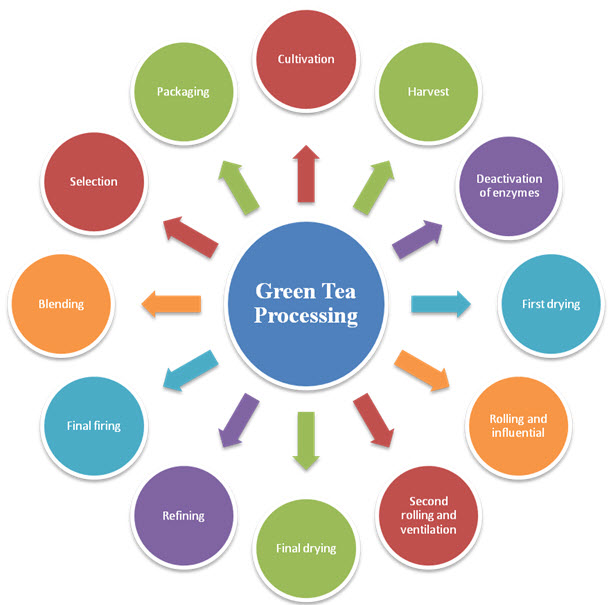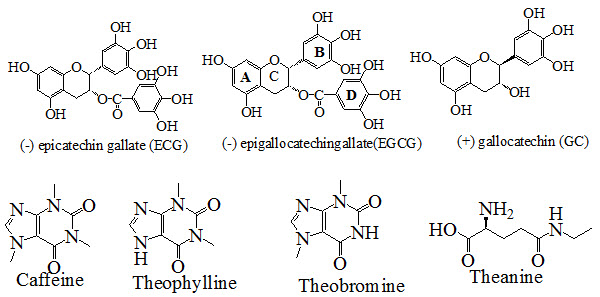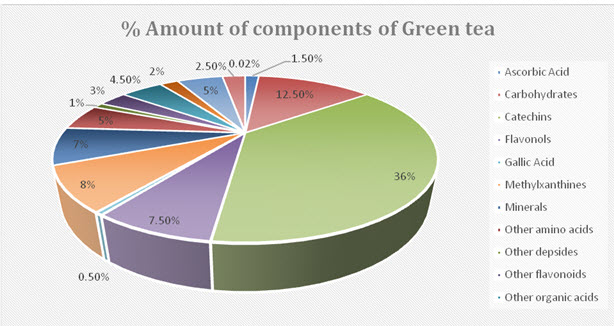{ DOWNLOAD AS PDF }
ABOUT AUTHORS
SUNIL JAIN*, HARVINDER POPLI, GEETA AGGARWAL, MADHU GUPTA
Dept. of Pharmaceutics, School of Pharmaceutical Sciences
Delhi Pharmaceutical Sciences and Research University,
New Delhi -110017
ABSTRACT
It is worldwide accepted that green tea have supernatural property to fight against chronic diseases such as cancer and many more. The presence of polyphenols in green tea is having such property to protect against severe disease and have antioxidant potential. The purpose of this review to explore the beneficial antioxidant potential of green tea with compilation of previously published literature. Green tea is produced from the leaves of the Camellia sinensis plant has provided to be the most popular beverages worldwide. Now people from 160 countries in the world are accustomed to tea drinking although the amount of green tea consumption in worldwide is less than other tea and coffee. Generally, green tea has been found to be superior to black tea in terms of health benefits due to their greater health benefits their demands and popularities are enhanced. The processes used in the manufacture of black tea are known to decrease levels of the monometric catechins to a much greater extent than the less severe conditions applied to other teas. Green tea is accounted for to contain a large number of bioactive fixings which are nearly contributed by polyphenols which assumes a key part of counteractive action and treatment of numerous infections and diseases. The major polyphenols in green tea are catechins, epicatechin (EC), epigallocatechin (EGC), epicatechin gallate (ECG) and epigallocatechin gallate (EGCG). Epigallocatechin gallate is viewed as the most significant active component. This review highlights chapter will highlight the antioxidant activities of green tea that is connected with the high cell reinforcement parts of green tea. This article shows the advantages of green tea for its calming, cancer prevention agent potential and oral human services. Despite the fact that the human clinical information is as yet constrained, this article demonstrates that green tea has its place in both the traditional and elective medicinal groups.
Reference Id: PHARMATUTOR-ART-2597
|
PharmaTutor (Print-ISSN: 2394 - 6679; e-ISSN: 2347 - 7881) Volume 6, Issue 7 Received On: 20/05/2018; Accepted On: 13/06/2018; Published On: 01/07/2018 How to cite this article: Jain, S., Popli, H., Aggarwal, G. and Gupta, M. 2018. Green Tea - An Antioxidant Mystic Herb. PharmaTutor. 6, 7 (Jun. 2018), 23-31. DOI:https://doi.org/10.29161/PT.v6.i7.2018.23 |
INTRODUCTION [Jigisha et al., 2012; Baptista et al., 1998, Shishikura et al., 2005; Hashimoto et al., 2000]
Green tea was introduced approx.10th century BC. Typically used as a hot or cold beverage. It is an evergreen shrub that can grow up to of heights 30 feet but is usually pruned to 2-5 feet for cultivation. It is obtained from unfermented leaves of Camellia sinensis plants containing complex protein, carbohydrates, lipids, vitamins, flavonoids. Flavonoids are a group of phytochemicals which are responsible for health effects. Flavanoids generally contain higher amounts of disease-fighting antioxidants called polyphenols. Polyphenols additionally show to diminish the thermo-beginning and fortify fat oxidation, boosting the metabolic rate without expanding the heart rate. As compared to other teas, green tea has the highest concentration of polyphenols including (–)-epigallocatechin gallate (EGCG). If the amount of polyphenols is increased it creates more bitter taste. Higher concentration of phenolic compounds in green tea are gallic acid (GA), (–)-gallocatechin (GC), (+)-catechin (C), (–)-epicatechin (EC), (–)-epigallocatechin (EGC), (–)-epicatechin gallate (ECG), (–)-epigallocatechin gallate (EGCG). The active constituent of tea varies with climate, season, variety, horticultural practices and the age of the leaf Green tea leaves are heated soon after harvesting so that enzymatic activity is stopped in order to retain the majority of catechin flavonoids and its green colour.
Processing of Green Tea [Cooper et al., 2011; Lin et al., 2003]
On the basis of the production process, tea may be categorized into 4 types: fermented (black tea), semi-fermented or partly fermented (oolong tea), post-fermented (pu-erh), and non-fermented (white, yellow, and green tea). There are various steps in the production process that determine the type of tea will be obtained after processing. After the plucking, tea leaves undergo withering. Withering is the process which is done to remove moisture and soften the leaves. The production of green tea involves an initial heating process, which kills the enzyme polyphenol oxidase. Polyphenol oxidase is responsible for the black colour of the tea due to the conversion of flavonoids in the leaf into the dark polyphenolic compounds. Duration of withering depends on the type of tea: white tea leaves are withered for 4–5hrs, whereas green, oolong and black tea are withered for at least twice as long. Green tea in north-eastern states of India has a high content of polyphenols which would be responsible for green tea excessively bitter. The other important process is rolling in which the leaves are cut and rolling/twisted. Rolling/twisting of tea leaves is performed by both manually and machines. This process is done to distort tea leaves to release tea oils and to enable the access of enzymes to polyphenols, which is essential for the oxidation process. This involves two major types of processing: orthodox and cut-tear-curl (CTC). Conventional moving alludes to hand preparing or moving with machines that mirror hand rolling. CTC machines empower more fast and broadleaf to twist, delivering littler particles and offers more prominent surface regions for enzymatic oxidation. This method is mainly used for commercial tea in the form of teabags.


Figure 2 Processing of Different Types of Tea
Amongst all types of tea, green tea is the richest in catechins (figure 2). Generally, the phenolic compound composition of green tea resembles that of unprocessed tea leaves. Essentially, flavon-3-ols contribute to the antioxidant capacity of green tea and its sensory properties. The content of individual phenolic compounds in green tea products varies widely.
In Chinese green tea, dry heating is employed in order to deactivate oxidase.
In Japanese green tea, steaming is employed to deactivate oxidase. This variety of green tea is typically shadow grown, and it contains a lower content of catechins and more amino acids compared to Chinese-style tea.
In India (especially Assam) green tea steaming, pan-firing or dipping in boiling water in order to deactivate oxidase.
Antioxidants Potential of Green Tea [Su et al., 2007; Baptista et al., 1998; Shishikura et al., 2005; Stewart et al., 2005; Leung et al., 2001]
Antioxidants potential of green tea is the major focusing area of health effects. Polyphenols compose green tea more beneficial in protecting the body from oxidative damage due to free radicals. As compared to other teas, green tea has the highest concentration of polyphenols including EGCG. Higher the content of polyphenols bitter will be the tea. Higher concentration of phenolic compounds in green tea are gallic acid (GA), (–)- gallocatechin (GC), (+)-catechin (C), (–)-epicatechin (EC), (–)-epigallocatechin (EGC), (–)- epicatechin gallate (ECG), (–)-epigallocatechin gallate (EGCG). Other than, it contains carotenoids, tocopherols, ascorbic acid (vitamin C), minerals such as Cr, Mn, Se or Zn, and certain phytochemical compounds Theaflavins in dark tea and catechins in green tea are likewise powerful as cell reinforcement.
Mechanism of antioxidant activity [Halliwell B et al., 1994; Zhao B et al., 2001; Sang S et al., 2003; Kelly MR et al., 2001; Anderson RF et al., 2001]
The greater part of the catechins has a wide cluster of organic activities relating especially to their compound structure. At present, huge numbers of the catechins' activities have been recognized, however, the systems behind these activities have not been completely illustrated. Their most popular and generally eminent natural activity is their cancer prevention agent and free radical rummaging properties. In any case, it is the developing proof of assorted activities on exchange cell pathways that has pulled in so much consideration as of late. Moreover, the catechins' glucuronide metabolite that structures B-ring O-methylated catechins has little cell reinforcement movement because of its decreased H-giving properties, however, can ensure against cytotoxicity as successfully as its parent compound.

Health Effects and Benefits of green tea [Lambert et al., 2007; Clifford et al., 2013; Stalmach et al., 2009; Henning et al., 2004; Clarke et al., 2014; Van et al., 2001]
The production of active metabolites by the components of green tea that undergo several metabolic processing like glucuronidation, methylation, and sulfation. Various studies resulted that after consumption of green tea there is a detection of catechins and their metabolites in blood plasma, urine and different tissues of the body. There are various parameters by which the measurement of ingested green tea extract has to be conducted bioavailability of blood plasma is studied after 2 hrs of ingestion and of urine is after 4-6hrs of ingestion. The metabolites like EC and EGC is to be detected in blood plasma and urine. From the last two decades, a number of researchers have been led to determine the health benefits attributed to consumption of green tea and its extracts. These research has shown that green tea has a variety of potential health benefits. These benefits include:
|
Beneficial health effects |
Reference |
Remarks
|
|---|---|---|
|
Anti-carcinogenic |
Roomi et al., 2005 |
Supplement blend tried fundamentally stifled tumor development of bosom growth cells in female athymic naked mice and altogether restrained MMP articulation, angiogenesis, and attack in bosom disease cells, in vitro, offering the guarantee for restorative use in the treatment of bosom malignancy. |
|
Chemo-preventative |
Yang et al., 2009 |
The catechins contain green tea inhibit carcinogenesis that helps in increasing the levels of glutathione S-transferase pi (GST-pi). This level catalyzes the detoxification reactions that inhibit carcinogen-induced DNA damage. |
|
Anti-inflammatory |
Jigisha et al., 2012, Serafini et al., 2011; Ahmed et al., 2008; Leong et al., 2014. |
It stimulates the production of the anti-inflammatory cytokine, IL 10; synthesis and signaling and regulation of IL-6 also restrict the production of matrix metalloproteinases via TNF-α that induced various phosphorylation |
|
Antioxidant |
Babu et al., 2008 |
the catechins of green tea have antioxidants inhibiting transcription factors and pro-oxidant enzymes, scavenging ROS, and inducing anti-oxidant enzymes |
|
Anti-platelet |
Ok et al., 2012; Lee et al., 2013 |
Cellular functions that related to platelet activation are affected like arachadonic acid pathway, calcium increase in the cytoplasmic region, production of thromboxane A2 (TXA2) decreases, and cyclooxygenase-1 (COX)-1is inhibited |
|
Anti-obesity |
Bogdanski et al., 2012; Suzuki-Sugihara et al., 2016 |
Green tea catechins lowers total cholesterol and LDL levels by reducing blood pressure. Catechins bind with LDL particles that reduce the oxidation of LDL by radical-trapping ability and act as hydrogen donors to α-tocopherol radicals production |
|
Anti-microbial |
Reygaert et al., 2014 |
Catechins of green tea disrupt the bacterial cell membrane that bounds the synthesis of bacterial fatty acid, protein tyrosine kinase, cysteine proteinases, DNA gyrase, ATP synthase. Of this property bacterial growth inhibits by efflux pump method in the presence of catechins |
|
Periodontitis |
Gaur et al., 2014; Awadalla et al., 2011; Kato et al., 2009 |
Catechins having positive stimulation towards probing depth, loss of attachment, gingival bleeding, and dentin erosion. EGCG has the ability to inhibit the bacteria which binds to oral epithelial cells via fimbriae and has inactivated bacterial collagenases. |
|
Dental care |
Gaur et al., 2014; Kato et al., 2009 |
The binding ability of EGCG reduce salivary and bacterial amylases formation and also reduces the synthesis of acid from carbohydrates. |
NOW YOU CAN ALSO PUBLISH YOUR ARTICLE ONLINE.
SUBMIT YOUR ARTICLE/PROJECT AT editor-in-chief@pharmatutor.org
Subscribe to Pharmatutor Alerts by Email
FIND OUT MORE ARTICLES AT OUR DATABASE
Composition of antioxidant compounds [Kanwar et al., 2012; Balentine et al., 1997]
To find out the antioxidant and anti-inflammatory properties of a compound characteristic property of structure helps such as the presence of a benzo-pyran structure having at least one aromatic ring shows the presence of antioxidant and anti-inflammatory properties of the respective compound.


EGCG shown in fig., includes a benzenediol ring (labeled A) joined to a tetrahydropyran moiety (C), a pyrogallol ring (B) and a galloyl group (with the D ring).

CONCLUSION: Green tea is expended all around the world in different structures. The times of safe utilization of this refreshment, upheld by various investigations demonstrating medical advantages, warrant a general proposal to expend it consistently. At present, there has been an expanded intrigue all-inclusive to distinguish cancer prevention agent possibilities of green tea which is pharmacologically intense and have low or no side effects for use in defensive solution and the sustenance Industry. Expanding information of cell reinforcement phytoconstituents and incorporate them in every day uses and eating regimen can give adequate help to a human body to battle those sicknesses. Green tea is developing as the normal solution for all the wellbeing related issues. With the most recent headway in the advances, different possibilities of green tea have been investigated. This has prevailed with regards to bringing the predictable enthusiasm of individuals toward the medical advantages related to this homegrown endowment of nature to the humanity. It isn't amazing that step by step green tea and its items are catching the worldwide market and its utilization has likewise expanded unbelievably. The credit for this surprising accomplishment is connected with the high cell reinforcement parts of green tea. This article shows the advantages of green tea for its calming, cancer prevention agent potential and oral human services. Despite the fact that the human clinical information is as yet constrained, this article demonstrates that green tea has its place in both the traditional and elective medicinal groups.
REFERENCES
1. Ahmed S, Marotte H, Kwan K, Ruth J.H, Campbell P.L, Rabquer B.J et al (2008); Epigallocaetchin-3-gallate inhibits IL-6 synthesis and suppresses transsignaling by enhancing soluble gp130 production; Proceedings of the National Academy of Sciences; 105(38); 14692–14697.
2. Anderson RF, Fisher LJ, Hara Y, Harris T, Mak WB, Melton LD et al (2001); Green tea catechins partially protect DNA from OH radical induced strand breaks and base damage through fast chemical repair of DNA radicals; Carcinogenesis; 22(8); 1189-1193.
3. Awadalla H.I, Ragab M.H, Bassuoni M.W, Fayed M.T, Abbas M.O (2011); A pilot study of the role of green tea use on oral health; International Journal of Dental Hygiene; 9(2); 110–116.
4. Babu P.V, Liu D (2008); Green tea catechins and cardiovascular health: An update; Current Medicinal Chemistry; 15(18); 1840–1850.
5. Balentine D, Wiseman S, Bouwens L (1997); The Chemistry of Tea Flavonoids; Critical Reviews in Food Science and Nutrition; 37(8); 693–704.
6. Baptista JAB, Tavares JFD, Carvalho RCB (1998); Comparison of catechins and aromas among different green teas using HPLC/SPME-GC; Food Research International; 31(10);729–736.
7. Bogdanski P, Suliburska J, Szulinska M, Stepien M, Pupek-Musialik D, Jablecka A (2012); Green tea extract reduces blood pressure, inflammatory biomarkers, and oxidative stress and improves parameters associated with insulin resistance in obese, hypertensive patients; Nutrition Research; 32(6); 421–427.
8. Clarke K.A, Dew T.P, Watson R.E, Farrar M.D, Bennett S, Nicolaou A, Rhodes L.E, Williamson G (2014); High performance liquid chromatography tandem mass spectrometry dual extraction method for identification of green tea catechin metabolites excreted in human urine; Journal of Chromatography. B, Analytical Technologies in the Biomedical and Life Sciences; 972; 29–37.
9. Clifford M.N, Van der Hooft J.J, Crozier A (2013); Human studies on the absorption, distribution, metabolism, and excretion of tea polyphenols; American Journal of Clinical Nutrition; 98(6); 1619S–1630S.
10. Cooper R (2012); Green tea and theanine: health benefits; International Journal of Food Sciences and Nutrition; 63(S1): 90–97.
11. Engelhardt UH, Lakenbrink C, Pokorny O (2004); Nutraceutical Beverages: Chemistry, Nutrition, and Health Effects; Shahidi F, Weerasinghe DK. Editors; American Chemical Society; Washington; 254-264.
12. Gaur S, Agnihotri R (2014); Green tea: A novel functional food for the oral health of older adults; Geriatrics & Gerontology International; 14(2); 238–250.
13. Halliwell B, Cross CE (1994); Oxygen-derived species: their relation to human disease and environmental stress; Environmental Health Perspectives; 102 (Suppl 10); 5– 12.
14. Hashimoto R, Yaita M, Tanaka K, Hara Y, Kojo S (2000); Inhibition of radical reaction of apolipoprotein B-100 and alpha-tocopherol in human plasma by green tea catechins. Journal of Agricultural and Food Chemistry; 48(12) : 6380–6383.
15. Henning S.M, Niu Y, Lee N.H, Thames G.D, Minutti R.R, Wang H, Go V.L, Heber D (2004); Bioavailability and antioxidant activity of tea flavanoids after consumption of green tea, black tea, or a green tea extract supplement; American Journal of Clinical Nutrition; 80(6); 1558–1564.
16. Jigisha A, Nishant R, Navin K, Pankaj G (2012); Green tea: A magical herb with miraculous outcomes; International Research Journal of Pharmacy; 3(5); 139–148.
17. Kanwar J, Taskeen M, Mohammad I, Huo C, Chan T, Dou Q (2012); Recent Advances on Tea Poly-phenols; Frontiers in Bioscience (Elite Edition); 4; 111–131.
18. Kato M.T, Magalháes A.C, Rios D, Hannas A.R, Attin T, Buzalaf M.A (2009); Protective effect of green tea on dentin erosion and abrasion; Journal of Applied Oral Science; 17(6): 560–564.
19. Kelly MR, Geigerman CM, Loo G (2001); Epigallocatechin gallate protects U937 cells against nitric oxide-induced cell cycle arrest and apoptosis; Journal of Cellular Biochemistry; 81(4); 647-658.
20. Lambert J.D, Sang S, Yang C.S (2007); Biotransformation of green tea polyphenols and the biological activities of those metabolites; Molecular Pharmaceutics; 4(6); 819–825.
21. Lee D.H, Kim Y.J, Kim H.H, Cho H.J, Ryu J.H, Rhee M.H, Park H.J (2013); Inhibitory effects of epigallocatechin-3-gallate on microsomal cyclooxygenase-1 activity in platelets; Biomolecules & Therapeutics; 21(1); 54–59.
22. Leong D.J, Choudhury M, Hanstein R, Hirsh D.M, Kim S.J, Majeska R.J et al (2014); Green tea polyphenol treatment is chondroprotective, anti-inflammatory and palliative in a mouse posttraumatic osteoarthritis model; Arthritis Research & Therapy; 16(6); 508-520.
23. Leung L.K, Su Y, Chen R (2001); Theaflavins in Black Tea and Catechins in Green Tea are Equally Effective Antioxidants; Journal of Nutrition; 131(9); 2248-2251.
24. Lin YS, Tsai YJ, Tsay JS, Lin JK (2003); Factors affecting the levels of tea polyphenols and caffeine in tea leaves; Journal of Agricultural and Food Chemistry; 51(7);1864–1873.
25. Ok W.J, Cho H.J, Kim H.H, Lee D.H, Kang H.Y, Kwon H.W et al (2012); Epigallocatechin-3-gallate has an anti-platelet effect in a cyclic AMP-dependent manner; Journal of Atherosclerosis and Thrombosis; 19(4); 337–348.
26. Reygaert W.C (2014); The antimicrobial possibilities of green tea; Frontiers in Microbiology; 5; 434.
27. Roomi MW, Ivanov V, Kalinovsky T, Niedzwiecki A, Rath M (2005); In vitro and in vivo antitumorigenic activity of a mixture of lysine, proline, ascorbic acid, and green tea extract on human breast cancer lines MDA-MB-231 and MCF-7; Medical Oncology; 22(2); 129-38.
28. Sang S, Tian S, Wang H, Stark RE, Rosen RT, Yang CS et al (2003); Chemical studies of the antioxidant mechanism of tea catechins: radical reaction products of epicatechin with peroxyl radicals; Bioorganic & Medicinal Chemistry; 11; 3371-3378.
29. Serafini M, Del Rio D, Yao D.N, Bettuzzi S, Peluso I (2011), “Health benefits of tea. In Herbal Medicine: Biomolecular, and Clinical Aspects”, Wachtel-Galor S. Editors, 2nd edition, Benzie I.F.F, CRC Press: Boca Raton, FL, USA, pp. 239–262.
30. Shishikura Y, Khokhar S (2005); Factors affecting the levels of catechins and caffeine in tea beverage; estimated daily intakes and antioxidant activity; Journal of the Science of Food and Agriculture ; 85(12); 2125–2133.
31. Stalmach A, Troufflard S, Serafini M, Crozier A (2009); Absorption, metabolism and excretion of Choladi green tea flavan-3-ols by humans; Molecular Nutrition & Food Research MNFR; 53; S44–S53.
32. Stewart A.J, Mullen W, Crozier A (2005); On-line HPLC Analysis of the Antioxidant Activity of Phenolic Compounds in Green and Black Tea; Molecular Nutrition & Food Research; 49(1); 52-60.
33. Su X, Duan J, Jiang Y, Duan X, Chen F (2007); Polyphenol Profile and Antioxidant Activity of Brewed Oolong Tea at Different Conditions; International Journal of Molecular Sciences; 8(12) ;1196-1205.
34. Suzuki-Sugihara N, Kishimoto Y, Saita E, Taguchi C, Kobayashi M et al (2016); Green tea catechins prevent low-density lipoprotein oxidation via their accumulation in low-density lipoprotein particles in humans; Nutrition Research; 36(1); 16–23.
35. Van Amelsvoort J.M, Van Hof K.H, Mathot J.N, Mulder, T.P, Wiersma A, Tijburg L.B (2001); Plasma concentrations of individual tea catechins after a single oral dose in humans; Xenobiotica; 31(12); 891–901.
36. Yang C.S (2009); Antioxidant and anti-carcinogenic activities of tea polyphenols; Archives of Toxicology; 83(1); 11–21.
37. Zhao B, Guo Q, Xin W (2001); Free radical scavenging by green tea polyphenols; Methods in Enzymology; 335; 217–231
NOW YOU CAN ALSO PUBLISH YOUR ARTICLE ONLINE.
SUBMIT YOUR ARTICLE/PROJECT AT editor-in-chief@pharmatutor.org
Subscribe to Pharmatutor Alerts by Email
FIND OUT MORE ARTICLES AT OUR DATABASE










.png)


